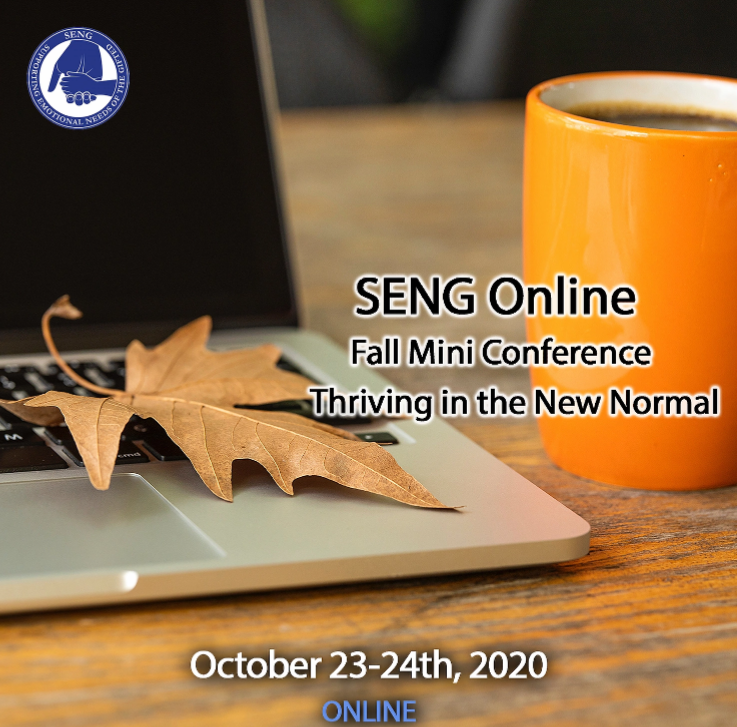
As promised, I’m returning with Part 2 of my reflections from SENG’s Fall 2020 Mini-Conference. Videos of all recorded sessions were recently shared with participants, and I had a chance to catch up on the ones I missed.
Here are the sessions I’ll be sharing my thoughts on in this post:
- Matt Zakreski’s “Fostering Creativity In and Outside of the Classroom”
- Jamie Castellano’s “Educating Gifted Students with Trauma”
- Sarah Ward’s “Practical Tips and Tricks to Increase Speed of Processing”
I will save my thoughts on Heather Boorman’s “Narcissism and the Gifted Soul” because I have enough to say on that topic to fill an entire post.
Matt Zakreski – who openly identifies as a “former gifted kid” and attendee at John Hopkins’ Center for Talented Youth – began his presentation on fostering creativity with definitions and key ideas from research. Creativity has been defined in various ways – from Michael Mumford’s notion that creativity “involves the production of novel, useful products”, to E. Paul Torrance’s position that creativity is “a process of becoming sensitive to problems” and then making and testing hypotheses to solve them, to James Averill’s description of Emotional Creativity (EC) as “a pattern of cognitive abilities and personality traits related to originality and appropriateness in emotional experience.”
Each of these definitions has its challenges and limitations, so Zakreski ultimately prefers looking at creativity as simply “the ability to create” and “the use of the imagination or original ideas” – rather than including qualifiers related to crafting something useful, solving problems, or exhibiting “appropriateness in emotional experience” (!) Zakreski noted that creativity has long been studied alongside intelligence – and given that gifted individuals are “naturally divergent thinkers” who “make connections and see relationships that others would not”, it makes sense to take a closer look.
I especially appreciated learning more about James Kauffman and Roland Beghetto’s notion of the “Four Cs” of creativity and how these may play out: mini-c “creativity” refers to “personal hacks” for learning (i.e., mnemonics and metaphors), while little-c “creativity” refers to everyday problem solving and “thinking outside the box”, pro-C “Creativity” refers to those who tap into their creativity as part of their profession, and Big-C “Creativity” refers to groundbreaking insights that transform the world. Of course, we hope that at least some gifted kids will ultimately land in the latter category, using their gifts for the betterment of humanity – but Zakreski pointed out that it’s important to honor and encourage all the “c”s, given that you never know where things may lead.
Jamie Castellano‘s presentation on “Educating Gifted Students with Trauma” was a no-holds-barred look at the significant traumas many gifted kids face – specifically ACEs (Adverse Childhood Experiences). By sharing his personal experiences working with gifted kids and teens experiencing trauma, he demonstrated the additional layers of support and rapport needed when working with this unique group of students.
Castellano shared his newly developed “5 Minute Whole Gifted Child Assessment”, designed to help teachers quickly identify students who may be struggling with ACEs. The assessment asks teachers to rank each of their students on a scale of 1-10 on each the following ten criteria: self-understanding, emotional understanding (of self and others), social relationships, productivity, physical health, mental health (happiness), resiliency, cognitive growth, academic aptitude, and exhibition of advanced and complex learning.
An overall score of 80-100 indicates that the student is “in the green zone cognitively, academically, socially, AND emotionally” with “no major concerns manifest[ing] themselves.” An overall score of 60-79 indicates the student is “in the yellow zone either cognitively, academically, socially, OR emotionally”, and that there may be “a pattern of where the student is challenged… in one area”, thus indicating the need for intervention. Finally, an overall score of 0-59 indicates the student “is in the red zone” in one or more areas and needs not only interventions and monitoring of progress but additional support from the school’s multi-disciplinary team.
Castellano’s presentation offered an invaluable supplement to our emergent understanding of twice-exceptional kids: some students may be struggling not only with the challenges of giftedness coupled with a disability, but also significant distress from environmental factors (ACEs) such as poverty, divorce, violence in the home, etc. Castellano didn’t touch much on identification of gifted kids experiencing trauma, but it seems logical that they would be significantly under-designated for gifted services – thus compounding the situation. We clearly have a lot of work to do in this area, and Castellano rightly identifies this as a key and critical topic for future exploration in the gifted community. Given my volunteer work with incarcerated adults, I’m especially interested in learning more about how many (often undesignated) gifted kids eventually end up justice-involved, given a combination of their high intensity and intelligence combined with challenging life circumstances; I will return to this topic in a future post.
Sarah Ward‘s presentation on “Practical Tips and Tricks to Increase Speed of Processing” was creatively designed, easy-to-follow, and offered a lot of new and useful information about executive functioning (EF). Since EF isn’t an area I struggle with myself, I’m always eager for any support I can get to “put myself in my kids’ shoes” – especially my 12-year-old daughter C., who is seriously struggling these days to keep up with online learning in middle school during the pandemic.
Early in her presentation, Ward shared a photo of a produce stall at a grocery store, and asked us to describe what we saw and how things seemed to be organized. From my perspective, I saw various types of colorful vegetables arranged in containers, with bell peppers (the prominent vegetable on display) further categorized into different colors (yellow, red, and green). Ward informed us that invariably – when she shows this photo to kids who struggle with executive functioning – they point out details in the photo (such as the “out of place” bell peppers) rather than the overall organizational schema.
Sure enough, when I showed the photo to my 12-year-old daughter C. and asked her “How are the peppers organized?” her immediate response was, “Badly”; she pointed to one red pepper that had fallen into the green pepper bin, and another which had fallen down into a yellow chili pepper bin. I had so instinctively looked for the overall categorization scheme in the setting that the “outliers” eluded me at first glance – but they IMMEDIATELY stood out to my daughter. So fascinating.
Ward explained that ADHD could/should more accurately be referred to as Executive Function Development Disorder, given that kids with ADHD tend to experience asynchrony of about 3-3.5 years in their developmental timeline with regard to how far into the future they can anticipate and plan for. For instance, kids in K-2nd grade (like my youngest daughter, I.) “should” be able to plan ahead for several hours, while kids in 3rd through 6th grade (like my son D.) “should” be able to plan ahead for 8-12 hours, and 6th-12th graders (like my 12-year-old daughter C.) “should” be able to plan ahead 2-3 days. These expectations make schooling challenging even for synchronously developing students – i.e., a high schooler who needs to plan ahead for an essay due in 3 weeks, who is really only thinking about the next few days – but it’s especially challenging for twice-exceptional kiddos.
So, what to do? Ward put forth a fascinating approach she referred to as Mimetic-Ideational Informational Processing (i.e., mental trial and error simulation). She began by explaining that Executive Functioning could be viewed as the following equation: non-verbal working memory + situational intelligence = mental dress rehearsal, or MIME: Make an image (what will it look like?), I (What will I look like?), M (How am I Moving?), Emotion (What will I feel like?).
Ward stressed numerous times that non-verbal working memory involves “visually holding information in your mind while mentally working with or updating it”, and pointed out that this is CRITICAL for managing anything that “unfolds over time”. She stressed that a checklist – even a visual checklist – doesn’t support kids in their non-verbal working memory because it’s a verbal working list. Checklists cue semantic recall, rather than episodic future memory.
Situational awareness refers to being able to “STOP and Read the Room” = that is, being aware of and navigating the space you’re entering into (what’s there? who’s there? what’s going on? what’s expected?), getting onto the timeline (what time of day is it? what’s happening at this moment?), being mindful of objects (where are critical objects located? what objects are NOT critical right now?), and reading the people in the room (what are they doing and saying with their voice and body language?).
My two biggest take-aways from Ward’s presentation were the ideas of 1) “block and box” (chunking a space or item out into discrete, labeled areas) and 2) taking a picture of the desired end result – such as a clean and organized bedroom – and using this as a “backward planning” guide (If… then) for success. If we can help kids literally picture where they want to be, they can engage in the MIME process and mentally rehearse (plan) the concrete series of steps they’ll need to take to get there. She emphasized the importance of gesturing while articulating this plan (“When we gesture, we’re pre-experiencing our plan”), which most definitely jives with recent research I’ve seen related to, just for instance, gesturing and memory.
I will report back on how these strategies work with my kiddos – and will share about one more SENG session (“Narcissism and the Gifted Soul”) in my next blog post.
Copyright © 2020 by HalfoftheTruth.org. Please feel free to share with attribution.
